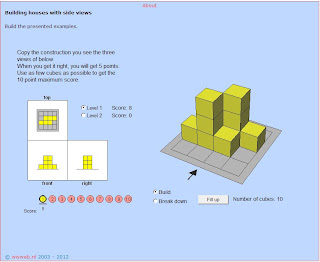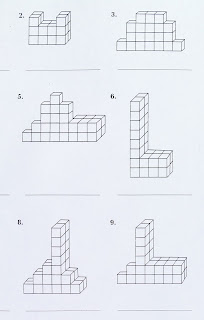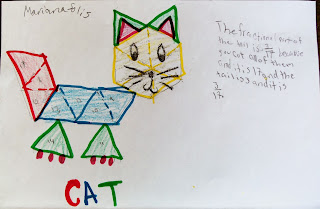7.G.A.3 Describe the two-dimensional figures that result from slicing three-dimensional figures, as in plane sections of right rectangular prisms....
Galilea proudly shows her building plans for the letter G. Great job, Gali!!
You can see the front view, top view, and side view on her Building Plans activity sheet.

Cristal and Esmeralda study the front of the building to determine which blocks show, and how they can draw this orthogonal view on their activity sheets.

Jimmy constructs his robot and rotates it on his half sheet of paper that is marked with the words front and side so he won't get confused as he turns his shape.
Make sure the students rotate the paper and not the shape as they turn it. This helps them keep track of where the front of the object is.
Here's a great computer resource that emphasizes my point.
Building Houses Activity

Fatima is looking down on her shape to see the top view.

Jessi holds his paper at eyelevel to see the front of his building.

Leslie uses the construction mat to determine the front and side views of her building.

Kimberly constructs a challenging building, and I'm impressed with how well she is able to show the various orthogonal views.
Way to go, Kimberly!!
Notice the second set of building plans that go with her building construction seen above in her photo.
Later, I showed the students how to label their building plans on the base (or top view) in order to construct each of the three views.
We talked about saving building costs by using the fewest number of blocks possible--without changing any of the viewpoints.
This is also a great Mom and Me Math activity!
Even little brother is enjoying the activity.
Thanks for your wonderful support and encouragement, Mom! This builds tremendous self-esteem in the child, too.
It also helps parents understand the homework, the new standards, and why spatial development is important for their children.
When it was our turn for the computer lab, I taught the children how to use Google SketchUp. They felt like real architects and loved creating their own shapes, textures, and building designs.

Here is a third grade enrichment activity from the student homework book that correlates with this activity.
The children loved figuring out this brainteaser puzzle! Can you determine how many cubes it takes to build this tower?

At first, some of my students thought they only needed to color the top row of blocks. However, make sure they color the entire row of blocks seen from the top or the side as they look at their shapes.
Mariana realized that the top view of her duck did not just include the top two blocks of its head, but also included its nose and tail blocks as well.

Cesar, does your front view match your beautiful drawing? Did you rotate the cube shape or the construction mat when you turned your design?
This is the most difficult part of the activity and needs to be stressed before the children begin drawing their plans on paper.

Well done, Jessi!! Here you can see his top view...
front view...
and side view.
Excellent work, Jessi! :)
































































